中英颜色词的文化差异与翻译(英文翻译版)
- 格式:doc
- 大小:86.00 KB
- 文档页数:8
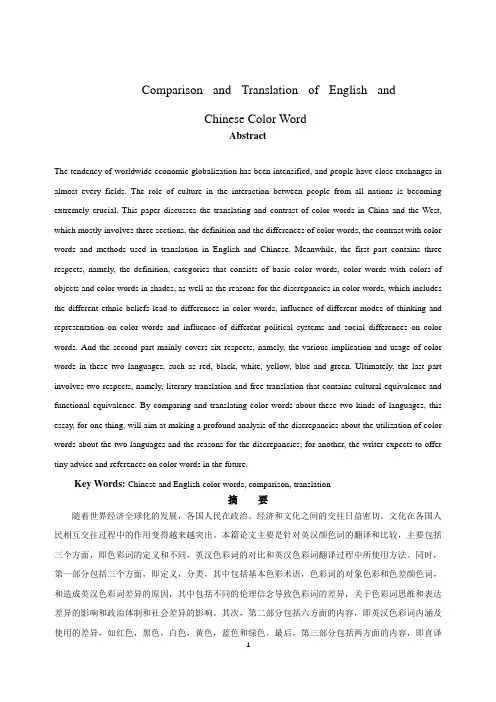
Comparison and Translation of English andChinese Color WordAbstractThe tendency of worldwide economic globalization has been intensified, and people have close exchanges in almost every fields. The role of culture in the interaction between people from all nations is becoming extremely crucial. This paper discusses the translating and contrast of color words in China and the West, which mostly involves three sections, the definition and the differences of color words, the contrast with color words and methods used in translation in English and Chinese. Meanwhile, the first part contains three respects, namely, the definition, categories that consists of basic color words, color words with colors of objects and color words in shades, as well as the reasons for the discrepancies in color words, which includes the different ethnic beliefs lead to differences in color words, influence of different modes of thinking and representation on color words and influence of different political systems and social differences on color words. And the second part mainly covers six respects, namely, the various implication and usage of color words in these two languages, such as red, black, white, yellow, blue and green. Ultimately, the last part involves two respects, namely, literary translation and free translation that contains cultural equivalence and functional equivalence. By comparing and translating color words about these two kinds of languages, this essay, for one thing, will aim at making a profound analysis of the discrepancies about the utilization of color words about the two languages and the reasons for the discrepancies; for another, the writer expects to offer tiny advice and references on color words in the future.Key Words: Chinese and English color words, comparison, translation摘要随着世界经济全球化的发展,各国人民在政治、经济和文化之间的交往日益密切。

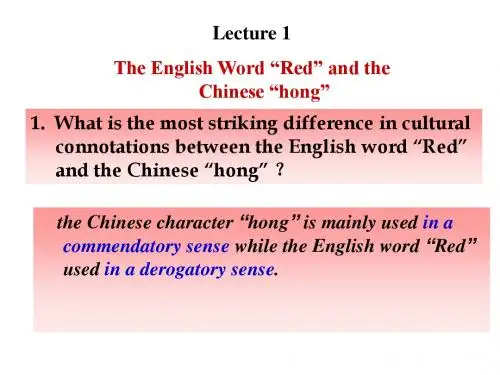
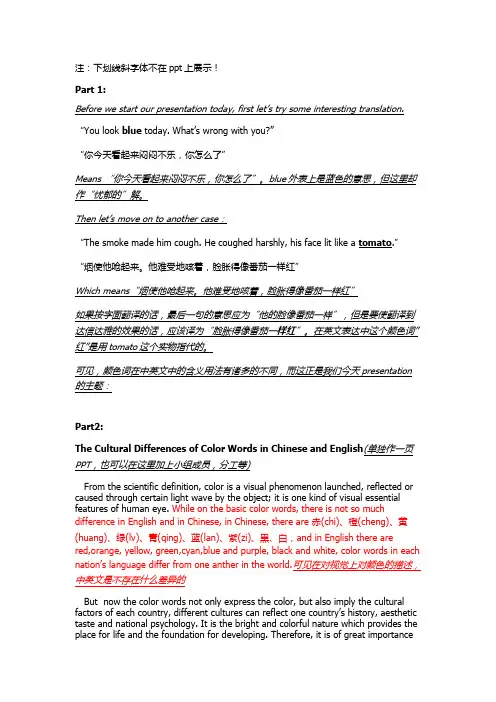
注:下划线斜字体不在ppt上展示!Part 1:Before we start our presentation today, first let’s try some interesting translation. “You look blue today. What’s wrong with you?”“你今天看起来闷闷不乐,你怎么了”Means “你今天看起来闷闷不乐,你怎么了”。
blue外表上是蓝色的意思,但这里却作“忧郁的”解。
Then let’s move on to another case:“The smoke made him cough. He coughed harshly, his face lit like a tomato.”“烟使他呛起来。
他难受地咳着,脸胀得像番茄一样红”Which means“烟使他呛起来。
他难受地咳着,脸胀得像番茄一样红”如果按字面翻译的话,最后一句的意思应为“他的脸像番茄一样”,但是要使翻译到达信达雅的效果的话,应该译为“脸胀得像番茄一样红”。
在英文表达中这个颜色词”红”是用tomato这个实物指代的。
可见,颜色词在中英文中的含义用法有诸多的不同,而这正是我们今天presentation 的主题:Part2:The Cultural Differences of Color Words in Chinese and English(单独作一页PPT,也可以在这里加上小组成员,分工等)From the scientific definition, color is a visual phenomenon launched, reflected or caused through certain light wave by the object; it is one kind of visual essential features of human eye. While on the basic color words, there is not so much difference in English and in Chinese, in Chinese, there are 赤(chi)、橙(cheng)、黄(huang)、绿(lv)、青(qing)、蓝(lan)、紫(zi)、黑、白,and in English there are red,orange, yellow, green,cyan,blue and purple, black and white, color words in each nation’s language differ from one anther in the world.可见在对视觉上对颜色的描述,中英文是不存在什么差异的But now the color words not only express the color, but also imply the cultural factors of each country, different cultures can reflect one country’s history, aesthetic taste and national psychology. It is the bright and colorful nature which provides the place for life and the foundation for developing. Therefore, it is of great importanceto study color words to find out how they reflect cultural differences in both the original and target language and why they can influence our daily life.然而在象征意义和文化含义上,中英文对颜色的理解就十分明显了,并且了解这种差异对于我们学习英语来说是非常有必要的In specific. The main colors of English and Chinese are same or similar,but some color words in one language can refer to more one color in other language. So the English and Chinese color words are not always corresponding word. Take the colorsof red, black, white, yellow, green and blue for examples as showed below.REDBoth in China and English speaking countries, red always be connected with joyous and celebrate events. For example, “red-letter days” in English means memorial day, often refers to Christmas Day. ”to paint the town red” means binge, quaff, or even monkey business〔狂欢痛饮胡闹〕“roll out the red carpet for sb.”〔铺展红地毯隆重地欢送某人〕.red also used to express some sorts of emotion. For instance, “become red-faced”or “sb’s face turned red” has the same meaning with “脸红” in Chinese. And “to see red ” along with “wave a red flag” equals to “为难、发怒” in Chinese.In Chinese particularly, the word “ hong ” represents luck, happiness, success, celebration and festival. In traditional Chinese weddings, not only the decorations are full of red color, including red candle, red quilts, red words “喜”and so on, but also the clothing of the bride and groom, as well as the red veil of the bride〔新娘的红盖头〕, thus bringing a wedding atmosphere and implying the prosperous future of the newlyweds. Furthermore, the word “红火”represents exuberant and lively. The word “红利” , describes the enterprise division of profits to shareholders or bonuses to staff. The word “红颜” refers to a young and beautiful woman.But in English, the word “ red ” represents danger, violence and debauchery〔放纵;沉湎酒色〕 with strong derogatory〔贬义的〕 meaning. When talking about the word red, people always imagine the fire and blood. For instance, “ red-faced ” represents embarrassed or angry; “ red alert ” is a warning that something very dangerous is likely to happen; “ the red rules of tooth and claws ”〔残杀和暴力统治〕means tyranny or a cruel, harsh, and unfair control over other people. With the cultural exchange, the word “ red ” in English comes to have some complimentary sense, such as “ red carpet ” used to welcome very important visitors as the speci al treatment when they arrive. However, in English “ red ” has different meanings in economy, such as “ in the red ” “ get into the red ” both mean somebody is in debt. So “ red ” is really the word making people happy at some time, but upset at other time.No matter in China or western countries, as a darker color, “黑” or “ black ” often has something to do with dirtiness, illegality, death, mourning, sadness, despair, an ger and justice. “V icious”“bad” are common meanings of black in both Chinese and English.In China, “乌黑的手” is what we call dirty hands. “黑市” implies the listed commodities trading allowed without government's approval, “黑车” means the illegal taxi with a higher charge. In the funeral, Chinese will tie a black band around one arm to show the sad feeling. If people get angry, we see the expression “他黑着个脸”. Sometimes “黑” symbolizes the justice, because in ancient China, we had a famous righteous officer called “包拯”, who had black complexion.In western country, “ a black sweet ”“ black water ” mean dirty. “ Black money ” indicates the income earned in an illegal way. Black is also a color for mourning dress (丧服)in Western countries. “ A black dog ” and “ black mood ”both refer to the low spirit of people. When people get angry, they look “ black-browed ” or “ black in the face ” or “ as black as thunder ”, and they also have“ black passion ”.WhiteSimilarities:The color white gives both Chinese and English the similar imagination to some extent. Take “pure” and ”innocent” for example , which means “纯洁,清白无辜的”. In Chinese, the word “白” is the symbol of death, depression and failure. In the funerals, traditional Chinese people always wear white mourning dress to express condolences to the dead. The funeral can also be called “白事” in Chinese. Also, the word “白” has the meaning of the civilian, such as “白丁” represents the illiterate people or the uneducated common people. In traditional drama, the implications of the word “白” is treachery. That is why the famous ancient politician,曹操, was described as “白脸奸臣”.On the contrary, the word “ white ” refers to the chastity, hope, happiness, joy and naivety in English. “ A white lie ” means a lie that you tell someone in order to protect them or avoid hurting their feelings. If someo ne is said to be “ white-handed ”, it means he or she is honest or innocent. In the Bible, the Angels are always with a pair of white wings and a silver-white halo overhead. White is the incarnation〔具象化〕 of being smart, kind and beautiful. the bride always dresses in a white wedding dress as a symbol of pure and beautiful.In ancient China, the word “黄” is a kind of noble color because it signifies the color of the skin of the Chinese people. When it came to “黄”, the majority of Chinese people will be reminded of the yellow clothes which the emperor wore. So, there are a lot of words with “黄”, such as “黄道吉日” with the meaning of the lucky day suitable to do things and “黄袍加身” with the meaning of acclaiming emperor. Nowadays, this word is associated with sex in Chinese. The word “扫黄”is the symbol of the elimination of the pornography and prostitution(淫秽制品以及卖淫嫖娼).As the color of gold and the sun, “ yellow” is the symbol of wealth, honor and power in English. It’s a holy color in Christianity. The Father wears golden crucifix 〔十字架〕, and the holy cup used by Jesus in his last supper is also yellow. In English, there is a phrase “ a yellow ribbon ”, used as a symbol of welcome for those people who will return home. So “ to hang yellow ribbons for somebody ” is to give awarm welcome for one’s return. “ Yellow ” sometimes implies warning. “ A yellow card ” is a card held up by a football referee to show that a player has done something wrong. Later it is used generally throughout the world as a symbol of warning.GreenGreen is a sort of color full of vigor and energy underlying life, youth, hope, peace and energy both in Chinese and English.In Chinese, there is another saying of “绿”, that is “青”, so there exists such phrases as “青春年华”, “常青树”. At present, the color “绿” also means environmental protection, such as in the phrase: “ the Green Party ”, “ Green Revolution ”, “ green food ”, “ green consumerism ” and so forth.But comparatively speaking, green has more associative indications in English such as “ green hands ” and “ be in the green ”, which mean being inexperienced. What’s more, the implications of green can also be envious and jealous, such as “ green with envy ”, “ green as jealousy ” and “ green-eyed monster ”. In Britain as well as in the United States, the color green is one of the favorite colors, and there are many places decorated with green color and even US dollars are green. Thus the color term “ green ” is often used to refer to money or fortune.BlueIn Chinese, the word “ 蓝” represents the color of the sky and water, symbolizing calm, reflection, modesty and the intellect. In fact, the implications of Chinese word“ 蓝” is less. To Chinese people, blue is the color of the dress worn by Confucian scholars in ancient times, and “蓝衫”was once used to refer to “秀才”, who passed the imperial examination at the county level in Ming and Qing dynasties.In English, the word “ blue ” commonly is a metaphor of depression, frustration, sorrow and anguish. If somebody is “ in a blue mood ”, he or sh e may feel sad, gloomy and depressed. Similar in meaning is “ a blue Monday ”, indicating the first day of work or school after a pleasant, happy weekend. Moreover, blue denotes high social position or being aristocratic〔贵族的〕. For instance, “ blue-blooded ” describes someone who have been born into a family which belongs to a royal or noble family or the highest social class. In contrast, another meaning of “ blue ” in English is connected with sex. “ Blue movie ” means a movie showing a lot of sexual activ ity, and “ blue talk ” means a talk which is coarse〔粗俗的〕.Part3:The Reasons for Different Culture Connotation between English and Chinese Color Words1、Natural EnvironmentsWe know the weather of England is always warm and the wool spinning industry has developed rapidly in England from early time.Thereby,English people often use sheep or wool as analogue. For example,there is wool so white but a dyer call make it black(羊毛虽白,染之则黑)As rice is the main food in china, Chinese is accustomed to using “米黄色” to describe the yellow just like the color of rice, while in western countries, butter and cream is the daily food, so “cream ” or “ butter- yellow” is often used in English. But in English yellow also has meanings of vulgar and despicable which has nothing to do with pornographic as yellow means in Chinese. This kind of usage began in 1895.New York world published picture story caricature yellow kids that was printed in yellow.Yellow journalisms and yellow covered literatures are just some vulgar publications.2、Historical BackgroundsIn Chinese, “绿帽子” (lv mao zi) is a metaphor, which means to be a cuckold. This kind of usage appropriately began in Tang dynasty. At that time, the male in brothel should wear a green hat to represent their identity. Chinese ancients viewed green as an impure color and represents low class. Therefore, the one whose wife has a paramour is called “戴绿帽子”. While western countries have no similar historic background, they don’t understand the meaning inside. In translation, it can not be simply translated into “He wears a green hat”, but “a cuckold husband”。
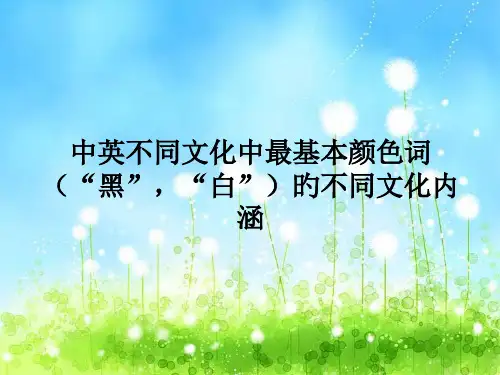
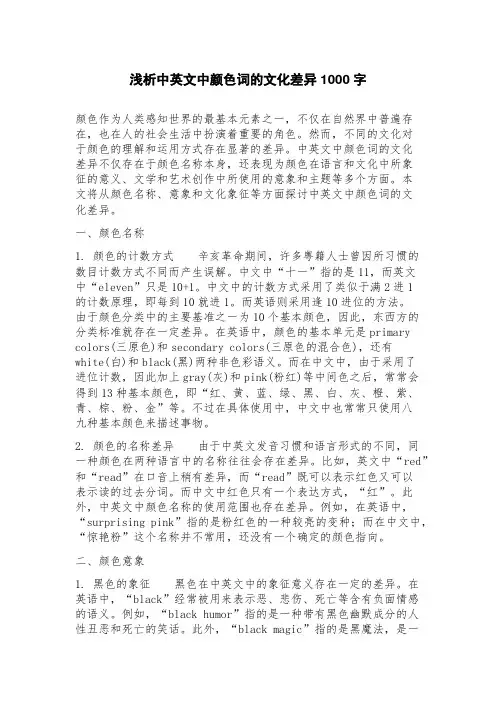
浅析中英文中颜色词的文化差异1000字颜色作为人类感知世界的最基本元素之一,不仅在自然界中普遍存在,也在人的社会生活中扮演着重要的角色。
然而,不同的文化对于颜色的理解和运用方式存在显著的差异。
中英文中颜色词的文化差异不仅存在于颜色名称本身,还表现为颜色在语言和文化中所象征的意义、文学和艺术创作中所使用的意象和主题等多个方面。
本文将从颜色名称、意象和文化象征等方面探讨中英文中颜色词的文化差异。
一、颜色名称1. 颜色的计数方式辛亥革命期间,许多粤籍人士曾因所习惯的数目计数方式不同而产生误解。
中文中“十一”指的是11,而英文中“eleven”只是10+1。
中文中的计数方式采用了类似于满2进1的计数原理,即每到10就进1。
而英语则采用逢10进位的方法。
由于颜色分类中的主要基准之一为10个基本颜色,因此,东西方的分类标准就存在一定差异。
在英语中,颜色的基本单元是primary colors(三原色)和secondary colors(三原色的混合色),还有white(白)和black(黑)两种非色彩语义。
而在中文中,由于采用了进位计数,因此加上gray(灰)和pink(粉红)等中间色之后,常常会得到13种基本颜色,即“红、黄、蓝、绿、黑、白、灰、橙、紫、青、棕、粉、金”等。
不过在具体使用中,中文中也常常只使用八九种基本颜色来描述事物。
2. 颜色的名称差异由于中英文发音习惯和语言形式的不同,同一种颜色在两种语言中的名称往往会存在差异。
比如,英文中“red”和“read”在口音上稍有差异,而“read”既可以表示红色又可以表示读的过去分词。
而中文中红色只有一个表达方式,“红”。
此外,中英文中颜色名称的使用范围也存在差异。
例如,在英语中,“surprising pink”指的是粉红色的一种较亮的变种;而在中文中,“惊艳粉”这个名称并不常用,还没有一个确定的颜色指向。
二、颜色意象1. 黑色的象征黑色在中英文中的象征意义存在一定的差异。

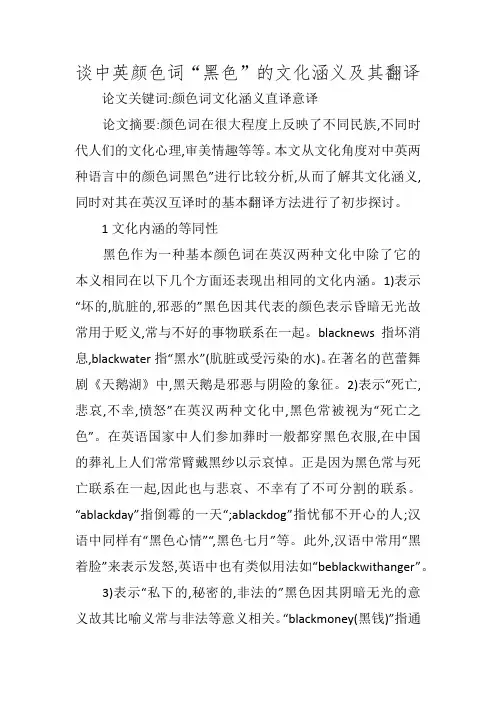
谈中英颜色词“黑色”的文化涵义及其翻译论文关键词:颜色词文化涵义直译意译论文摘要:颜色词在很大程度上反映了不同民族,不同时代人们的文化心理,审美情趣等等。
本文从文化角度对中英两种语言中的颜色词黑色”进行比较分析,从而了解其文化涵义,同时对其在英汉互译时的基本翻译方法进行了初步探讨。
1文化内涵的等同性黑色作为一种基本颜色词在英汉两种文化中除了它的本义相同在以下几个方面还表现出相同的文化内涵。
1)表示“坏的,肮脏的,邪恶的”黑色因其代表的颜色表示昏暗无光故常用于贬义,常与不好的事物联系在一起。
blacknews指坏消息,blackwater指“黑水”(肮脏或受污染的水)。
在著名的芭蕾舞剧《天鹅湖》中,黑天鹅是邪恶与阴险的象征。
2)表示“死亡,悲哀,不幸,愤怒”在英汉两种文化中,黑色常被视为“死亡之色”。
在英语国家中人们参加葬时一般都穿黑色衣服,在中国的葬礼上人们常常臂戴黑纱以示哀悼。
正是因为黑色常与死亡联系在一起,因此也与悲哀、不幸有了不可分割的联系。
“ablackday”指倒霉的一天“;ablackdog”指忧郁不开心的人;汉语中同样有“黑色心情”“,黑色七月”等。
此外,汉语中常用“黑着脸”来表示发怒,英语中也有类似用法如“beblackwithanger”。
3)表示“私下的,秘密的,非法的”黑色因其阴暗无光的意义故其比喻义常与非法等意义相关。
“blackmoney(黑钱)”指通过违法手段得到的不义之财,类似的还有“blackmarket(黑市)、blacklist(黑名单)black-hearted(黑心的,邪恶的)、blackdeeds(恶劣行径)。
汉语中同样有“黑户、黑钱、黑货、黑店”等等。
4)表示“庄重、正义”黑色除了表示消极意义也表示积极意义。
在我国古代,黑色是一种尊重和庄重的颜色,是夏朝和秦朝所崇尚的正色,缁衣(黑色帛做的衣服)则是卿士听朝的正服。
因黑色和铁的颜色相似,我国古人常将铁的坚硬特征与黑色联系起来,用黑色来象征“刚直、公正无私”,因此在中国戏曲脸谱艺术中,往往用黑色脸谱来象征历史人物的秉公执法,刚正不阿等高尚品质,最典型的代表是宋朝的包拯。
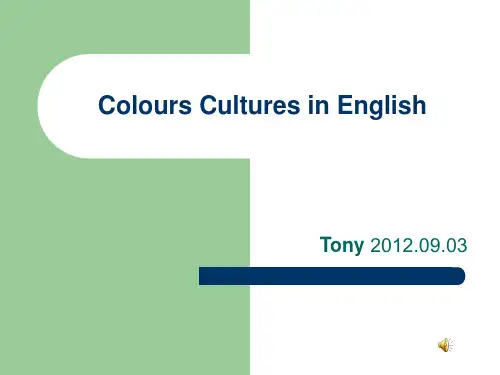
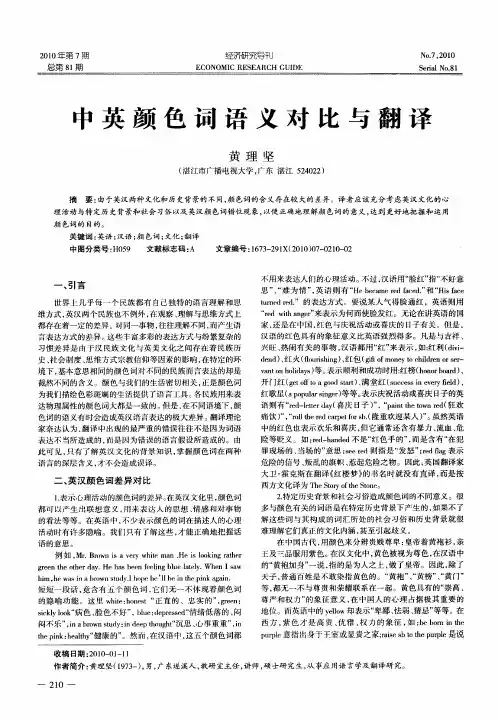
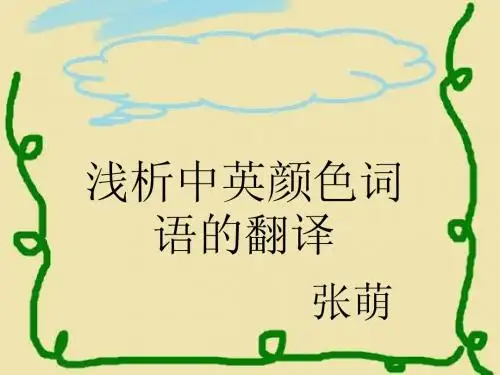
中英颜色词的文化和翻译对比作者:曾晓梅来源:《学习周报·教与学》2019年第52期摘 ;要:英汉中许多与颜色有关的词,由于这两种语言属于两个完全不同的文化类别,因此这两种语言在赋予相同颜色的语义上具有相同和不同之处。
在理解和欣赏颜色词时,与之相关的语境含义、文化内涵、翻译差别显得尤为重要。
本文通过比较中英文颜色词,介绍了它们在含义和翻译上的异同。
关键词:颜色词;中英对比一、中英颜色词的背景信息(一)颜色词差异原因几个原因可以解释英汉颜色词的差异:独特的民族信仰;个性化的思维方式和表达方式;不同的政治形态和社会心理。
(二)颜色词分类中英文存在大量颜色词,不同语言在描述颜色时有着明显的相似之处。
颜色词的分类基本相同。
颜色词在英语和汉语中基本上分为三类:1.基本颜色词是指可以显示事物颜色的词。
英文和中文有一些常见的颜色词,如黑、白、红、黄、绿。
2.物质性颜色词指通过自然色彩在自然界中的物体上的显示来表达颜色的词。
如炭黑——carbon black。
3.阴影颜色词表示通过自然光或来自太阳的白光显示在不同的对象上,呈现明暗不一的阴影而显示出的颜色,比如说“金黄”。
二、中文与英文的颜色词翻译相同颜色被认为是事物的客观存在。
不同的人在同一颜色上具有相同的外部表现,并且人们的思想有一些相似之处。
这导致使用颜色词时有一些相同或相似之处。
例如:黑板——Blackboard;红旗——Red flag。
上面的示例是中文和英文翻译一一对应。
在中英文中,某些颜色词都很相同的内涵和翻译,例如红色都代表与节日有关的热情和喜庆,黑色用来代表庄严和肃穆,灰色代表萧条和沮丧,蓝色代表宁静、悲伤与和平,白色代表纯洁、孤独和沉浮。
三、中英文颜色词的翻译差异(一)红色不论是在过去还是现代中国文化中,红色都最流行的颜色之一。
自古以来,它就与庆祝、吉祥和温暖息息相关。
在中国,红色是胜利、吉祥、荣誉、活力等的象征。
在西方国家,红色具有相反的含义,红色多被赋予贬低之意。
从颜色词看中英文化差异
中国文化对颜色有着独特的理解和赋予,与英文文化存在一些差异。
下面是一些常见颜色词在中英文化中的差异:
1. 红色 (Red):在中国文化中,红色代表着喜庆、热情、吉祥和好运。
红色是中国文化中最喜欢的颜色,常用于喜庆的场合,如婚礼和春节。
而在英文文化中,红色通常与爱情、激情和力量相关。
2. 黄色 (Yellow):在中国文化中,黄色象征着皇权和尊贵。
中国古
代帝王常使用黄色作为皇家颜色。
黄色还象征着丰收和土地的肥沃。
而在
英文文化中,黄色通常与太阳、温暖、快乐和活力相关。
3. 白色 (White):在中国文化中,白色代表着清白、纯洁和丧事悼念。
白色常用于婚礼中新娘的婚纱以及葬礼上的丧服。
而在英文文化中,
白色通常与纯洁和无暇相关。
4. 蓝色 (Blue):在中国文化中,蓝色常与男性相关,代表着清澈和
纯净。
而在英文文化中,蓝色通常与忧郁和冷静相关,例如“Monday blues”表示星期一的低落情绪。
5. 绿色 (Green):在中国文化中,绿色与春天、生命和希望相关,
被视为吉祥的颜色。
而在英文文化中,绿色通常与自然、环保和生态相关,也与嫉妒相关(green with envy)。
这些是一些常见颜色词在中英文化中的差异。
颜色的文化赋予不仅体
现了不同的情绪和象征意义,也反映了不同文化对生活和世界的认知和态度。
中英文颜色词的文化内涵和翻译(一)【摘要】由于汉语和英语两种语言的文化差异,许多词汇蕴涵了不同的民族感情色彩,在翻译和交际过程中可能产生偏差和误解。
本文以颜色词汇为例分析解读了颜色词汇的不同文化内涵和感情色彩,以此达到增强语言交际能力、避免文化冲突的目的。
【关键词】颜色;词汇;文化差异;文化内涵Abstract:OwingtotheculturaldifferencebetweenChineseandEnglish,wordsar eembeddedwithdifferentnationalfeeling,whichwouldresultinmisunderstan dingevenwrongtranslationinthecourseofcommunication.Thisarticletakesso mecolorsforinstancetoanalyzeculturalconnotationsandhiddennationalfeeli ngsofvocabularyindifferentcountriessoastoimprovecommunicationandavoi dculturalconflicts.Keyword:colourvocabularyculturaldifferenceculturalconnotation对颜色的认知,是人类最基本的认知范畴之一。
虽然各种语言表达颜色的词汇数量差别较大,但是基本词汇,如黑、白、红、黄、绿、蓝等,在很多语言中都是相通的。
不过,由于各民族文化风俗、地理位置、历史传统、宗教信仰、民族心理、思维习惯等方面差异,颜色词语有时表现出各民族独特的“个性”,带有显著的文化烙印。
比如巴西人忌讳绿色,日本人忌讳黄色,泰国人忌讳红色,比利时人忌讳蓝色,土耳其人忌讳花色,欧美国家大多忌讳黑色。
颜色在不同的民族文化中承载了不同的内涵。
某些词汇包含多项文化内涵,其中某一个文化内涵可能与译入语完全契合,某一个可能部分对应,而另一个可能相互冲突。
The cultural differences of color words between English and ChineseTranslationAbstract: Red, white, black three color words have similarities in associative meaning, Chinese culture and Western culture in the symbolic meaning and semantics, and there are also differences,with the common, confusing phrases and idioms translation, let people know the importance of color words in English and Chinese in two cultures.Keywords:color words; symbolic meaning; cultural difference; idiomColor is closely related with human life, we every hour and moment is not in dealing with color. Represents various color words embody national cultural features of English and Chinese culture is different,the performance of different national "personality”, with significant cultural stigma. The same color words often contain different symbolic significance. Therefore, correctly grasp the deep meaning of color words in the two languages and the correct translation, master the vocabulary and idioms in the English language, has a role can not be ignored in cross—cultural communication。
This paper focuses on three color words: red (red), white (white), black (black), it is in the two languages of English and Chinese language and culture differences be explained, and some common translation and confusable vocabulary and idioms, for English learners.一。
REDWhether in China or in western countries, often live with festive red Move on, but in China the symbolic meanings of red more strongly。
Red symbolizes celebration, successful, thriving, warm,such as "full house",”good”,"fire”。
Chinese traditional wedding tone mainly in red, the bride wearing red clothes, cover red hijab, a red candle, with red hi word, a faction be burstingwith happiness. In the Anglo—American countries, the bride dressed in white wedding dress, wearing a white wedding dress。
"Red" stands for "fire" in British and American culture,"blood", ”agression”,"excitement”,”Rage","violence”, such as "seered",”red—handed", "a red battle" is reminiscent of violence and bloodshed. Red in China is also a symbol of revolution,such as "red", "be both red and expert”, while in English often pejorative meaning, with "red",”radical left.", Such as ”red belt", ”red activities”。
Red in Chinese also refers to people who favor or boss,such as ”red”, ”popular"; A joint-stock enterprises at the end of the year profits distributed to shareholders in economic terms,such as ”bonus","bonus”, While in English refers to economic or business often have ”deficit”,"loss" meaning, such as ”be in the red”,”red ink"。
Red refers to the color, has the same meaning in English and Chinese,refer to the ”red", "black”,"red” and other means, can be used as adjectives and nouns。
It refers to the traffic,with "red" in English and chinese.1. And "red" the relevant vocabulary, idioms and English to Chinese language1) 红白喜事——-weddings and funeralsChina known as the wedding for weddings, funerals for the funeral, and Anglo-American countries marriage funeral custom is different, So it should not be directly translated into "red and white happyoccasions” in translation, or foreigners will be terrified.2)红娘——-go— between/match— maker”Matchmaker" Yuan drama ”the West Chamber” heroine。
Yingying’s maid, she contributed to urge YingYing and Zhang Sheng binding, then folk is known as ”matchmaker” eager to others marriage,not a name.3)红粉;红颜——-a young beautyBoth the beauty, corresponding to the English "red" can’t, Wu Weiye of the Qing Dynasty "round”:”six Army Song wail with white mourning dress, re d crown anger as a confidante.”Chinese old beautiful woman die or be married to a bad husband is beautiful,often have ”since ancient times, confidante much"。
So in the translation should adopt free translation, avoid direct translation of color. For example,红颜薄命译为“a beautiful girl has an unfortunate life".4)《红楼梦》——-The Story of the Stone"A dream of Red Mansions" also known as ”stone”. A dream of Red Mansions in Chinese refers to the magnificent buildings, the old often refers to a rich woman. Many people directly translated into ”A Dream of the Red Mansion", but the British translator David Hawks in translation is not to take the literal translation, but taking into account the ”differences in English and Chinese culture, according to red” translate”a dream of Red Mansions” alias "stones".5)红本—-—memorials to the throne read and written in red by Chinese emperors The Ming Dynasty eunuch Liu Jin dictatorship, the memorial has two copies, a name for the emperor's white, a fine—sounding name red this to Liu Jin, but later until the Qing Dynasty, almost by Emperor Zhupi is red。